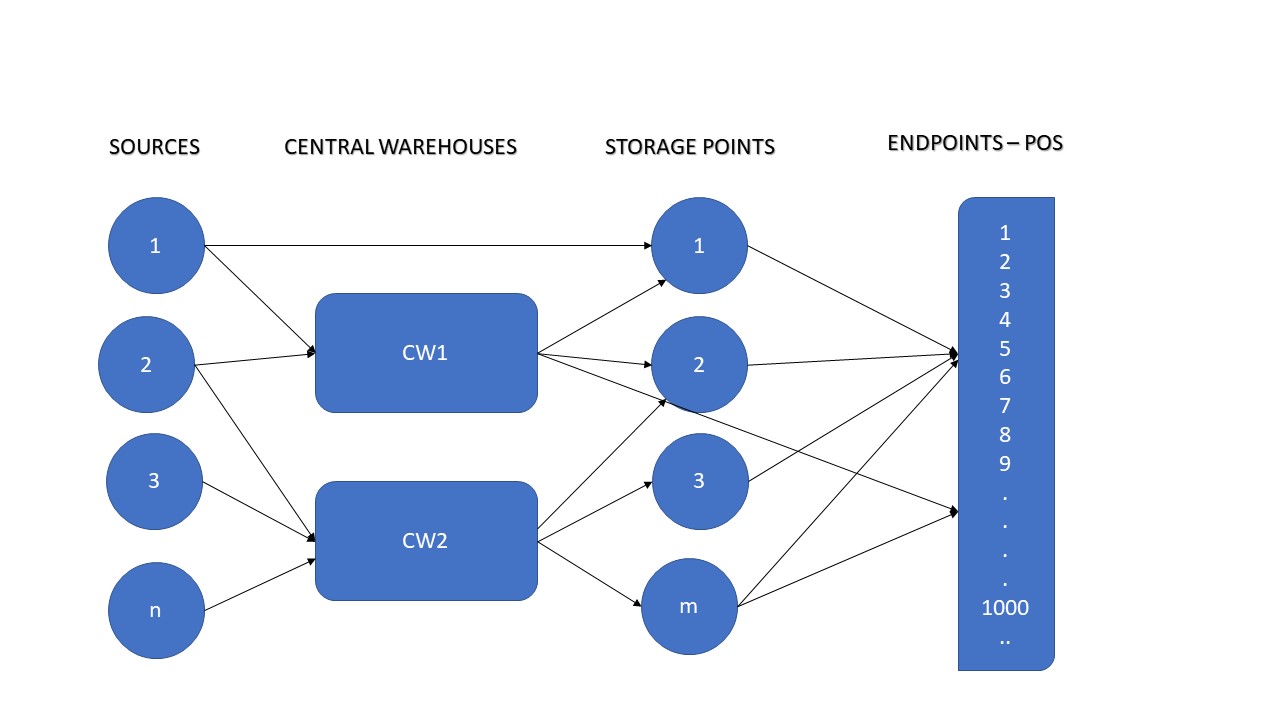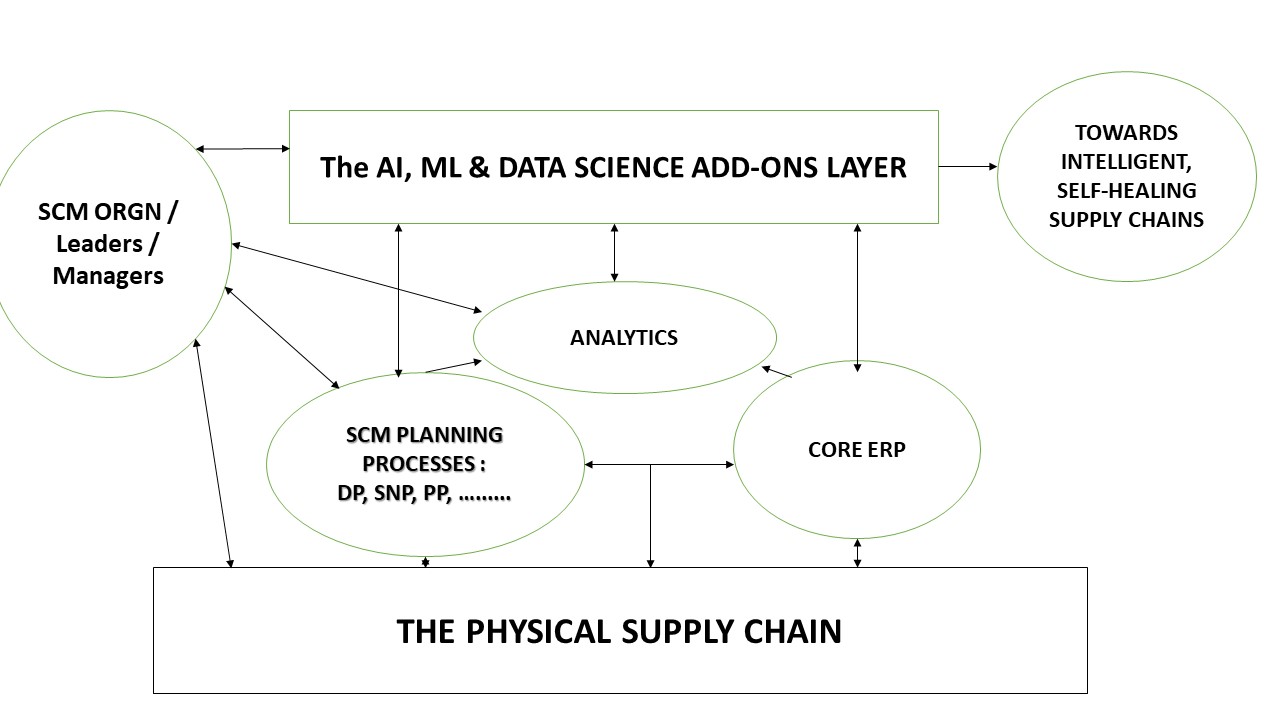This article was published as a part of the Data Science Blogathon.
Introduction
Supply Chain is a core component for most organizations. Hence implementation of Supply Chain Management (SCM) business processes is very crucial for the success (improving the bottom line!) of an organization. Organizations often procure an SCM solution from leading vendors (SAP, Oracle among many others) and implement it after implementing an ERP solution.
SCM solutions offer configurable processes covering end-to-end supply chain operations right from the procurement of raw materials to the sale of the finished product.
Most SCM solutions implement traditional algorithms and optimization as part of their backend logic and rarely use AI/ML algorithms.
The article explores AI/ML use cases that will further improve SCM processes thus making them far more effective. The use cases presented in the article are at a conceptual level and need further analysis and detailing to implement them.
To sum up, the successful use of AI/ML in SCM is expected to provide a path toward an intelligent, automated, and self-healing supply chain. Thus, it is certainly an important area to focus on!
SCM Defined
SCM definition, purpose, and key processes have been summarized in the following paragraphs.
1. Definition/Purpose: Supply-chain management has been defined as the “design, planning, execution, control, and monitoring of supply chain activities to create net value, building a competitive infrastructure, leveraging logistics, synchronizing supply with demand, and measuring performance”.
2. A typical Supply Chain: A typical large supply chain may have a network consisting of dozens of sources, central warehouses, hundreds of storage points, and thousands of POS cum storage endpoints. Linkages in the network are referred to as transportation lanes and define how products will be transported and where they will be stored. For such multi-echelon supply chains, inventory management is extremely complex. Diagram for a typical Supply chain:

3. Business Processes: Core business processes in an SCM solution are briefly described below:
· Demand Planning (DP): The business process for demand capture is implemented using a combination of simple statistical functions such as moving averages and demand numbers manually entered. DP is often done for multiple time horizons such as short-term (a month), medium-term (a quarter), and long-term (a year). The short-term demand numbers are finalized based on multiple inputs viz. statistical prediction, entered by the sales team, and/or derived from the long-term planning. Organizations often implement an approval step, where demand numbers are verified, modified, and approved by SCM managers after considering other factors such as business targets.
DP also includes many other functionalities such as splitting demand entered at a higher level of hierarchy (e.g., product group) to a lower level of granularity (e.g., product grade) based on the proportions derived earlier, etc.
Needless to say that as the time horizon size (time bucket) reduces (say to daily level) then forecast accuracy drops significantly.
The demand numbers thus finalized are released to the next module (Supply Planning) in the desired time buckets (day, week, etc.).
· Supply Planning / Supply Optimization / Supply Network Planning (SNP):
The module generates an optimal supply plan after considering current inventory levels at all storage points, inventory norms, push-pull strategies, production capacities, constraints defined, and many other design aspects in the supply chain. At its core, SNP involves generating & solving a large mathematical optimization problem using Mixed Integer Linear Programming (MILP) technique from the Operational Research (OR) tools repository. MILP is a very effective optimization technique, where variables defined can be either continuous or integer (taking binary values). Integer variables are typically used to define step functions and similar constraints. The optimization problem is generated by the SCM solution based on various configurations, master data (e.g., transportation lanes, capacity, etc.), constraints such as production capacity, and of course demand numbers. The output of the SNP module i.e., optimal supply plan is released to the next Production Planning module.
· Production Planning & Scheduling: Output of SNP is used for production planning & detail scheduling based on specific constraints in the production environment (e.g., sequencing of products, other dependencies, batch processing, etc.) in addition to capacities at every step.
· Delivery / Load Builder / Integration with the Transactional ERP: Involves generation of deliveries prioritized to avoid stockouts at endpoints, generation of a truckload, etc. It is also integrated with the transactional ERP system.
4. ERP Vendors: Leading vendors include SAP, and Oracle among many others.
5. Challenges / Issues faced: A few commonly experienced challenges while implementing SCM processes are listed below:
· Large number of products / SKUs
· High level of inventory
· Non-moving products / SKUs
· Lost sales in a few areas (due to shortages), while surplus in other areas.
· Reactive logistics
· Non-adherence to the plan i.e., discipline issues.
· Departmental focus (e. g. Sales team would like to enter demand numbers in line with the sales targets, which are generally on the higher side. Which often results in a bullwhip effect in the entire supply chain).
6. SCM KPIs: Typical KPIs used for monitoring SCM improvements:
· Demand fulfillment index
· Inventory Days of Supply (average)
· Forecast Accuracy (weighted average)
· Delivery Performance/dispatch adherence
· Production adherence
· Procurement adherence
· End-to-end cycle time (from procurement to sale)
AI/ML Applications in SCM
AI/ML applications that can be explored and implemented in the SCM space have been discussed in this section.
1. AI/ML-based Demand Planning:
Leading SCM vendors do offer functionality for Regression modeling or causal analysis for forecasting demand. The functionality is embedded in the DP module. However, if a more rigorous and advanced approach is desired, then one can forecast demand numbers outside of the SCM system using advanced modelling and then upload them back to the SCM system.
Advanced modeling may include using advanced linear regression (derived variables, non-linear variables, ridge, lasso, etc.), decision trees, SVM, etc., or using the ensemble method. These models perform better than those embedded in the SCM solution due to the rigor involved in the process.
Further, in addition to the above, one can implement a weighted average or ranking approach to consolidate demand numbers captured or derived from different sources viz. modelling, entered by the sales team, long-term planning, etc.
Whether deep learning (neural network) will help in forecasting the demand in a better way is a topic of research. Neural network methods shine when data inputs such as images, audio, video, and text are available. However, in a typical traditional SCM solution, these are not readily available or not used. However, maybe for a very specific supply chain, which has been digitized, the use of deep learning for demand planning can be explored.
2. AI/ML-based segmentation (clustering) of products:
Generally, while implementing an SCM solution, ABC analysis of SKUs (classifying products based on their importance i.e. on sales value or volume (quantity) or the margin, etc.) is done. Such classification is used for configuring, applying, and implementing a customized strategy for every class. Such analysis makes the implementation more effective because A-class products need completely different treatment as compared to the ‘C’ class. For example, for ‘A’ class products, the organization may not allow any changes to the numbers as predicted by the model.
A better approach will be segmenting SKUs using clustering (e. g. K-Means) and then applying different strategies to each segment. However, the interpretation of segments (clusters) has to be done manually by business analysts/data scientists. And same segments may be interpreted differently by different analysts. Maybe in the future, an AI-based algorithm will be available which will provide a better and more interpretable solution to the clustering problem.
3. Reinforcement Learning (RL) as an advisor:
Reinforcement Learning (RL) is the science of decision-making. It is the third paradigm in Machine Learning (other than supervised and unsupervised learning) for learning optimal behavior in an environment to obtain the maximum reward. The optimal behavior is learned through interactions with the environment and observations of how it responds, like children exploring the world around them and understanding the actions that help them achieve a goal. RL has been extensively used for playing games like chess.
Similarly, in a Supply Chain environment, the RL algorithm can observe planned & actual production movements, and production declarations, and award them appropriately. Hence RL algorithm can be used to fine-tune transactions in the supply chain. Unlike games like Chess, RL can be used as an advisor in the supply chain. However real-life applications of RL in business are still emerging hence this may appear to be at a very conceptual level and will need detailing.
4. AI/ML-based autocorrection in the supply chain
Normally supply & production planning processes are run as batch jobs on a weekly, fortnightly, and monthly basis as it is not feasible to run them daily and possibly impossible to run on a real-time basis. Rather it may not make sense to run them in real-time as it will create more confusion! However, a lot can change on a daily basis. So, if AI/ML algorithms can amend, adjust, and refine plans on a daily basis without running all logic embedded in the SCM systems, then it will be very useful to business users. Suggested approaches include a rule-based or heuristics or some other AI/ML algorithm, which will analyze the cumulative status of the supply chain (e.g., to date in the month) and amend the supply or production plan for the coming days/weeks.
5. AI/ML-based Production Planning and Scheduling:
Supply Planning or Supply network planning optimizes production using a production capacity at a very broad level. However, further optimization and scheduling are done using an advanced optimizer, which may consider additional constraints such as sequencing or constraints specific to a production process in the industry. If it is not feasible to optimize using MILP or other optimization algorithms, then specialized approaches like genetic programming are used.
Here one can borrow from sophisticated optimizers readily available as Python libraries.
6. Digital twin for the Supply Chain:
A modern Supply Chain is well connected by IoT devices, and all transactions are updated in real-time, hence it is possible to compute the majority of KPIs in real-time. The information on KPIs can be made available to management in real-time using a suitable dashboard.
Further using AI-ML-OR, if one can simulate the balance period and predict KPIs that will be achieved at the end of a period, given the status, supply plans, and past trends, then decision-makers will be able to take corrective action during the month itself without waiting for month-end. In many scenarios, KPIs are reported at the month-end or quarter-end, and sometimes, it becomes a ritual because, by that time, SCM teams would have already initiated actions towards the next period.
7. AI-based chatbots for the core SCM team
A chatbot can be very useful to various user departments such as sales, purchase, production others, which will access SCM databases and support queries using NLP modules. It is a very effective approach to answering queries written in natural language.
8. Classifying very odd sales/movement of products
A report showing very ‘odd’ product movements or production declarations will be very useful as it will help management to focus on those specific movements. However, this will obviously need labeling to be done for past periods i.e., classifying and labeling movements as ‘odd’ or ‘ok’.
9. Delivery / Truckload generation:
It involves the generation of delivery/truckload considering the following:
· Stock replenishment in the order of delivery priority (based on inventory status, delivery time, and inventory norms).
· As far as possible, generating a full truckload for a storage point makes sense in order to simplify logistics, to avoid multi-drop scenarios or suboptimal partial truckloads.
· Avoid excess delivery pushed to storage points while forming a truckload.
· And of course, depending on the inventory available at production centres.
Currently, various strategies and optimizers are being used to generate a delivery schedule and truckload. In the future, AI/ML may be able to provide a more ‘perfect’ solution to the above problem, which balances the requirements mentioned above.
Conclusion
Today SCM solutions are quite mature and offer a very good solution to streamline and improve the supply chains. With the adoption of the

Above mentioned AI/ML-based use cases, it will progress toward an automated, intelligent, and self-healing Supply Chain. Maybe SCM vendors will slowly incorporate some of them into their solutions. Architecturally it may appear as shown in the diagram above.
Below are some of the key takeaways from the article:
· Existing SCM processes & algorithms explained
· Areas for AI/ML applications in the SCM identified
· Use cases of AI/ML will make SCM solutions more effective, real-time, self-healing and intelligent!
The media shown in this article is not owned by Analytics Vidhya and is used at the Author’s discretion.




